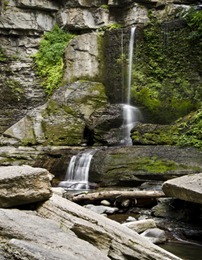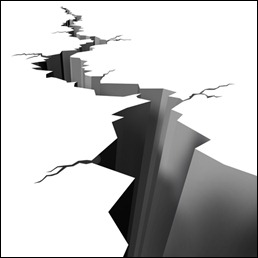Citizen Objections to Hydrofracturing Show NY DEC Statement Inadequacies
 At its final hearing venue on the most recent edit of its regulations over gas hydrofracturing in New York State in the Marcellus shale area, the state’s Department of Environmental Conservation found itself confronted with a well-informed, articulate and hostile citizenry who filled the 1000-seat Tribeca Performing Arts Center in downtown Manhattan. There were, by DEC’s own estimate, some 6000 who attended the four hearings spaced around the state, and some 600 who got to voice their dissatisfaction with the agency’s documents.
At its final hearing venue on the most recent edit of its regulations over gas hydrofracturing in New York State in the Marcellus shale area, the state’s Department of Environmental Conservation found itself confronted with a well-informed, articulate and hostile citizenry who filled the 1000-seat Tribeca Performing Arts Center in downtown Manhattan. There were, by DEC’s own estimate, some 6000 who attended the four hearings spaced around the state, and some 600 who got to voice their dissatisfaction with the agency’s documents.
While Scott Stringer, the Manhattan Borough President who has watch-dogged the DEP since it first tried to open NY State to fracking some two years ago, chatted with celebrities like Debra Winger and Mark Ruffalo at the entrance, speakers made the most of their three-minute allotment. Of the 100 speakers over the two three-hour periods, only four supported the state move into gas fracking. There was little nuance in the level of the rest’s objections: most were adamantly against permitting hyrdrofracturing anywhere in New York State.
Health and Staffing Concerns
One of the more frequent objections was the lack of mention in the over-600-page environmental impact statement of any consideration of any health impacts that the proposed fracking might entail. This is not only remarkable because of the severe and persistent health problems that fracking accidents have caused in other venues, but also because “public health and safety” is the entire mandate of the DEC.
Another major concern was the fact that the DEC is radically understaffed. Currently it has 19 inspectors who are supposed to monitor the 23,000 conventional gas wells that already exist in the state, let alone the 12,000 hydrofracturing wells for which permits have been applied so far. Yet, there has been no mention of increasing the staff, a situation which would make it impossible to monitor activity in any meaningful way at all.
Shale Economics
The economics of hydrofracking were also questioned by several speakers. With regard to costs, it was pointed out that no consideration had been given to the extensive costs that would be borne by taxpayers. In terms of operating costs, this included not only additional roads, but damage to existing roads; the cost of additional DEC inspectors and their equipment and operations if these should be hired; costs of the treatment of fracking water that reached public water facilities, and the possible expansion of these facilities to treat the chemicals contained in water used in hydrofracturing; and the cost of additional air monitoring and monitoring stations that should be performed and required.
In terms of residual costs, it was pointed out that there would most likely be serious loss of value of homes in any area where hydrofracturing activity existed. Even if there were never any accidents, the degradation of the environment, the air and noise pollution would impact not only housing value, but might prohibit homeowners from obtaining mortgages. As permitting industrial development on land where a home was mortgaged might put the mortgager, the homeowner, in default, this might also result in foreclosure. Another residual cost might occur when an area lost its appeal as a tourist destination, or when prime farmland had to be taken out of operation because of air and soil pollution.
The tens of thousands of jobs that have been touted by the industry and its supporters as coming to the state courtesy of gas hydrofracking were also questioned. It was noted that most of the jobs are temporary, and filled by experienced out-of-state workers much of whose wages support families in other states. In this context, the USGS’s recent report that the four-trillion cubic-foot potential of American shale gas had been greatly exaggerated. The agency’s report cut the recoverable amount down by 80 per cent, to 800 billion cu ft. This was supported by a dismaying figure from the Barnett Shale in Texas, where only six per cent of the wells turn out to be economically profitable – but of course, not until after the damage to the land had been done.
Seismic Considerations
 Concerns that the potential seismic activity that could be generated by fracking were not considered in the SGEIS were brought up by a number of speakers. Apparently the fault map that the Statement used showed only one fault in the Marcellus shale area. However, there is apparently an earlier map that shows the area threaded with small faults. If the quoted record of 91 earthquakes in the area since 1973 is accurate, multiple faults and greater danger of seismic activity should be a consideration.
Concerns that the potential seismic activity that could be generated by fracking were not considered in the SGEIS were brought up by a number of speakers. Apparently the fault map that the Statement used showed only one fault in the Marcellus shale area. However, there is apparently an earlier map that shows the area threaded with small faults. If the quoted record of 91 earthquakes in the area since 1973 is accurate, multiple faults and greater danger of seismic activity should be a consideration.
It was noted that the impact of seismic activity on New York City could be devastating. If one of the New York City’s main viaducts were affected, the city would lose one-third of its water supply within a day, while a repair could take months or even years.
A woman from Schoharie County said that the underlying geological configuration for this and surrounding counties is karst, limestone and similar rock which has been dissolved by water over millennia, leaving it full of open spaces and caverns. Karst is fragile, breaks easily and water travels through in unpredictable ways. The aquifers in karst regions are the most vulnerable. Because of the porousness of the terrain, surface water penetrates down even from heavy rainstorms. The fracture of a well bore going down through karst will have enormous consequences.
Radiation and Hazardous Waste
A geologist testified to his concern about the radiation inherent in shale gas. Like all shales, the Marcellus shale contains radon. Currently this has not been a problem for New York because the state and city get most of their gas from the south, from which it takes about 3 days to travel. Over those three days, most of the radioactivity has dissipated so that the gas we use emits only about one picocurie, well below the acceptable exposure level of about 10 picocuries. However, if we get our gas locally, it will not have dissipated its radiation and would likely, the geologist stated, still emit 120 to 140 picocuries, well above the acceptable level.
The chemicals in fracking fluid that are known include substances like benzene and toluene that are normally considered hazardous waste. But since the Cheney Amendment still seems to rule, fracking fluid is not classified as hazardous waste. It can therefore be sent to facilities that cannot remove the contaminants and return the contaminated water into the common water supply.
….and Other, Serious Problems
On the face of it, New York City is in the clear, but several speakers questioned the margin of safety for the city’s watershed. It limits a well head to an area at least 1000 feet from the edge of the city’s watershed, but for most formations, this distance is far too small. Nor does the regulation prevent the horizontal part of the well to extend under the watershed area. A distance of ten miles was a suggested minimum for the safety of the city’s 10-billion-gallon-a-day habit.
All in all, the consensus was expressed by Josh Fox, the maker of the film, “Gasland:” that the entire regulation argument is based on a fallacy. The question is not how hydrofracturing should be regulated, but whether it should be permitted at all. The DEC should not be trying to accommodate the extraction industry, but should be furthering alternative energy possibilities. In all, it should follow the precautionary principle: to err on the side of protecting the public health and environment, not minimizing the risk.


